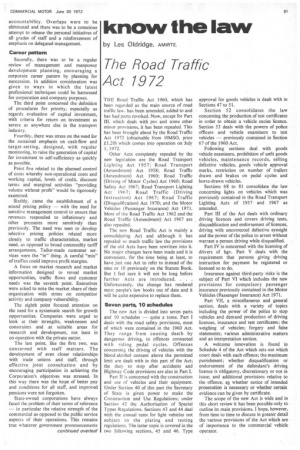know the law
Page 53

If you've noticed an error in this article please click here to report it so we can fix it.
by Les Oldridge, AMIRTE
The Road Traffic Act 1972
THE Road Traffic Act 1960, which has been regarded as the main source of road traffic law, has been amended, added to and has had parts revoked. Now, except for Part III, which deals with psv and some other minor provisions, it has been repealed. This has been brought about by the Road Traffic Act 1972 (obtainable from HMSO, price £1.20) which comes into operation on July 1, 1972.
Other Acts completely repealed by the new legislation are the Road Transport Lighting Act 1957; Road Transport (Amendment) Act 1958; Road Traffic (Amendment) Act 1960; Road Traffic (Driving of Motor Cycles) Act 1960; Road Safety Act 1967; Road Transport Lighting Act 1967; Road Traffic (Driving Instruction) Act 1967; Road Traffic (Disqualification) Act 1970; and the Motor Vehicles (Passenger Insurance) Act 1971. Most of the Road Traffic Act 1962 and the Road Traffic (Amendment) Act 1967 are also repealed.
The new Road Traffic Act is mainly a consolidating Act and although it has repealed so much traffic law the provisions of the old Acts have been rewritten into it. No major changes have been made and it is convenient, for the time being at least, to have just one Act to refer to instead of the nine or 10 previously on the Statute Book. But I feel sure it will not be long before further Acts are introduced. . . . Unfortunately, the change has rendered most people's law books out Of date and it will be quite expensive to replace them.
Seven parts 10 schedules
The new Act is divided into seven parts and 10 schedules — quite a tome. Part I deals with the road safety provisions, most of which were contained in the 1960 Act, They range from causing death by dangerous driving, to offences connected with riding pedal cycles. Offences concerning the driving of vehicles with the blood-alcohol content above the permitted limit are dealt with in this part of the Act; the duty to stop after accidents and Highway Code provisions are also in Part I.
Part II is concerned with the construction and use of vehicles and their equipment. Under Section 40 of this part the Secretary of State is given power to make the Construction and Use Regulations; under Section 42 the Authorisation of Special Types Regulations, Sections 43 and 44 deal with the annual tests for light vehicles not subject to the plating and testing regulations. The latter topic is covered in the two following sections, 45 and 46. Type approval for goods vehicles is dealt with in Sections 47 to 51.
Section 52 consolidates the law concerning the production of test certificates in order to obtain a vehicle excise licence. Section 53 deals with the powers of police officers and vehicle examiners to test vehicles — previously contained in Section 67 of the 1960 Act.
Following sections deal with goods vehicle examiners, prohibition of unfit goods vehicles, maintenance records, selling defective vehicles, goods vehicle approval marks, restriction on number of trailers drawn and brakes on pedal cycles and horse-drawn vehicles.
Sections 68 to 81 consolidate the law concerning lights on vehicles which was previously contained in the Road Transport Lighting Acts of 1957 and 1967 as amended.
Part III of the Act deals with ordinary driving Licences and covers driving tests, disqualification and endorsement of licences, driving with uncorrected defective eyesight and the power of the police to arrest without warrant a person driving while disqualified.
Part IV is concerned with the licensing of drivers of hgv. Part V deals with the requirement that persons giving driving instruction for payment be registered or licensed so to do.
Insurance against third-party risks is the subject of Part VI which includes the new provisions for compulsory passenger insurance previously contained in the Motor Vehicles (Passenger Insurance) Act 1971.
Part VII, a miscellaneous and general section, deals with a variety of topics including the power of the police to stop vehicles and demand production of driving licences, insurance and test certificates; the weighing of vehicles; forgery and false statements; various administrative matters and an interpretation section.
A welcome innovation is found in Schedule 4 of the Act which sets out which court deals with each offence; the maximum punishment; whether disqualification or endorsement of the defendant's driving licence is obligatory, discretionary or not in issue; and additional provisions relative to the offence, eg whether notice of intended prosecution is necessary or whether certain evidence can be given by certificate.
The scope of the new Act is wide and in this short review it has been possible only to outline its main provisions. I hope, however, from time to time to discuss in greater detail the various provisions of the Act which are of importance to the commercial vehicle operator.




























































































